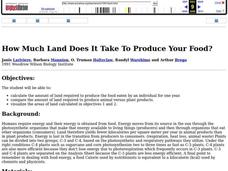Curated OER
How Much Land Does It Take To Produce Your Food?
Students calculate the amount of land required to produce the food eaten by an individual for one year. They compare the amount of land required to produce animal versus plant products. Students visualize the areas of land calculated.
Curated OER
Ocean Life Food Web
Students construct a food web representative of the Gulf of California. They use pictures to depict all of the organisms in the appropriate level of the web (producer, primary consumer, etc.)
Curated OER
Food Chains
Fourth graders study food chains, producers, consumers, and decomposers. They play a food chain game and create food chain mobiles or posters. They take a nature hike around the school and observe various parts of a food chain.
Curated OER
Life And Death
Students participate in an interactive game to review how living things are classified.
Curated OER
Forest Food Webs
Students consider the interdependency of life in a temperate forest by studying selected organisms from an Asian temperate forest and creating a food web.
Curated OER
Producers, Consumers, and the Food Chain
Third graders discuss producers, consumers, and the food chain. In this producers and consumers lesson plan, 3rd graders talk about organisms, the food chain, and the difference between producers and consumers. They complete review...
Curated OER
Economic Community
Fourth graders assume different jobs of a community and understand the terms goods, services, producer, and consumer. In this community lesson plan, 4th graders answer short answer questions to show their knowledge of the terms.
Curated OER
Getting to Know the Products from Trees
In this tree products lesson, young scholars read the book Tell Me,Tree: All About Trees for Kids, discuss how people make products from wood, define producers and consumers and then go on a treasure hunt for wood products at home and...
Curated OER
Food Chains in a Forest
Learners explore food chains in the forest. In this food chain lesson, students listen to the story The Tree in the Ancient Forest by Carol Reed-Jones. They create a food chain to match the story and then create a food chain of their own.
Curated OER
Ecology: The Food Web
In this ecology worksheet, learners match the vocabulary to the definitions, then represent producers and consumers by drawing a Pyramid of Numbers.
Curated OER
Economics: Products of South Louisiana
Students explore the economy of Louisiana. In this economics lesson, students examine the roles of farmers, processors, and distributors in food production and consumption. Students use flip cameras to record how selected products are made.
Curated OER
Label Language
Fourth graders explore food labels. In this consumer education instructional activity, 4th graders describe and evaluate various components of familiar food labels. Students discuss which traits make a product appealing to consumers....
Curated OER
Food Chains
Students investigate the food chain. In this ecology lesson, students define producers and consumers. Students use organism cards to demonstrate how the food chain works.
Curated OER
Producing and Consuming
Second graders make a booklet. In this economics lesson, 2nd graders define producers and consumers. They make an assembly line accordion booklet to demonstrate how producers and consumers work together to make and use goods.
Curated OER
Give it Back from a Snack
Students conduct and analyze a survey about snacks. In this graphing lesson, students ascertain which snacks would be the best choice for the community. Students hold a sale and decide how the money could best be spent for the school...
Curated OER
The Goat in the Rug
Students identify producers, resources and goods. In this economics lesson, students read the book The Goat in the Rug and define producers, resources, and intermediate goods. Students construct a rug which depicts the story of rug...
Curated OER
Food Chains and Webs
In this food chains worksheet, students identify the producers and consumers in the given food chains and describe how contaminants can biologically accumulate. This worksheet has 4 short answer questions.
Curated OER
The Biosphere
In this biosphere worksheet, students identify the different levels of organization that ecologists study. Students complete charts, sentences, and answer short answer questions.
Curated OER
What is a Food Web?
In this food web worksheet, students will brainstorm organisms and classify them as either a consumer, producer, or decomposer. Students will write the organisms under the correct category in this graphic organizer worksheet.
Curated OER
What Are Some Roles of Living Things?
In this living things worksheet, students will write in 1 main role living things play in their habitat and then write in 4 supporting details in this graphic organizer.
Curated OER
Energy in Cells
In this biology worksheet, 9th graders explain how producers make their own food. Then they describe the food chain and what the end products are of respiration. Students also describe how muscles continue to get energy during high...
Curated OER
Fossil Fuel Scavenger Hunt
In this earth science worksheet, students complete each of the statements with the correct fossil fuel. They identify when and where electricity first became available. Students also define fossil fuels and where they first got their...
Curated OER
Song Writing: Recording Your Song
In this music worksheet, students read an excerpt on recording with a company, who the producer is, and what arrangements need to be made. They respond to six short answer questions related to recording their own song in a studio.
Curated OER
Prior Knowledge Investigation-Food Webs
Students explore food webs. They identify any misconceptions of producers, consumers or decomposers and their relationship within a food web. Students draw an example of a food web for each of the examples that are given. They address...

























